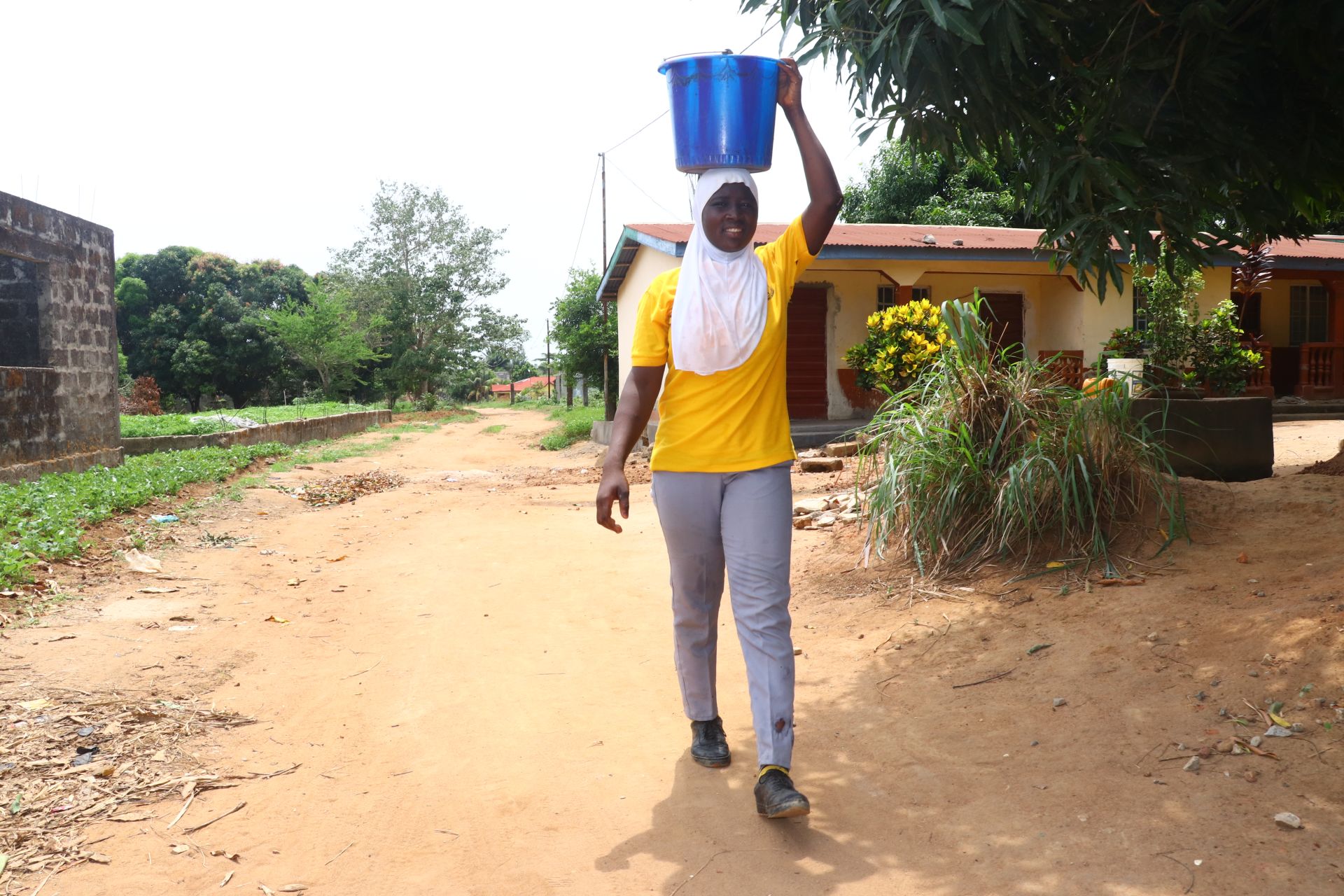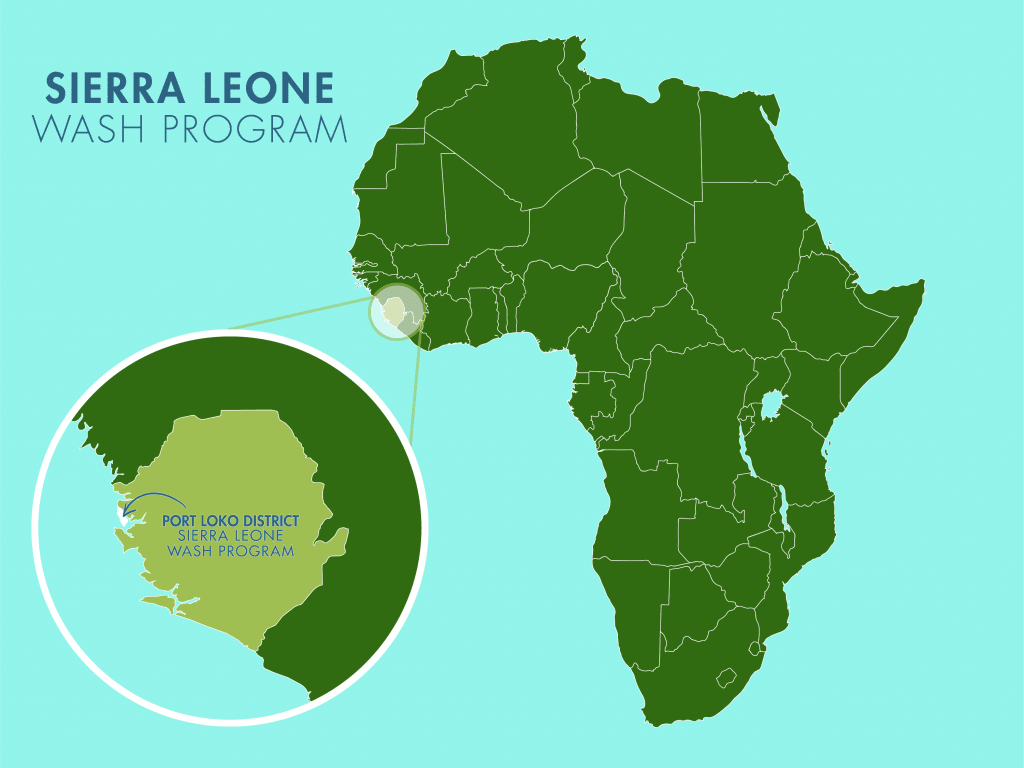At Kankalay Islamic Primary and Secondary School in Sierra Leone, sixteen-year-old Fatmata is one of 394 students who begin each day balancing her studies with a heavy responsibility — collecting water for her classmates and nine teachers.

Fatmata hauls water back to school.
The school’s main water sources are two hand-dug wells, one of which is protected and the other unprotected. When the closer, protected well runs dry, Fatmata and other students must walk far beyond the school grounds to fetch water at the other well. The trip can take up to two hours each day, as they travel across hilly terrain and wait their turn at the well.
“The distance to the water sources is very far, and I will spend minutes before I reach the wells. The place where these water wells are located has a hill. I will climb the hill with a bucket of water on my head, and I will take time not to get stuck. Also, there is no pump on the well, and I use [a] rope and a rubber gallon [bucket] to fetch water from these wells. This takes time and energy. All this takes me a lot of time before I can return to school. I will be happy if this project provides a water well in my school,” Fatmata shared.

Fatmata pours water into her bucket from the distant well.
For Fatmata, the time spent fetching water means less time in class and more exhaustion. She describes having to choose between meeting her physical needs and her education.
“I would not be able to spend all day fetching water because I must be in class listening to lessons. When my turn [comes] to fetch water, I go fetch water, then return to school. Sometimes, my teacher will tell me not to fetch water until he finishes teaching, so I will not miss out on the lesson," shared Fatmata.

The journey to collect water is not only tiring — it is dangerous. The steep hill leading to the wells often causes injuries, and Fatmata constantly worries about her safety.
“The water sources [are] located in a hilly area, and this makes me afraid to go fetch water. Climbing the hill is not easy, and I am always afraid [of] getting stuck. Some of my friends sometimes get stuck and injured. They will sit at home, and they will miss out on lessons. I do not want to be hurt or get stuck," Fatmata said.

Hauling water back to school.
But Fatmata hangs on to hope that a new water source will change everything.
“If I have access to a new water well in my school. This will greatly help me and my friends at school. I will not be climbing the hill to access the water. I will not get stuck anymore,” she shared.
The lack of nearby water also directly affects her learning.

Fatamata shared her frustration, “It does affect my time at school. I miss morning devotions, [and] also some lessons. I [am] not be able to get complete notes and [am] unable to focus on lessons. I find it difficult to study at home due to the lack of incomplete notes.”
Still, Fatmata dreams of a future, but for now, the burden of fetching water weighs heavily on her days — physically and emotionally.
“I feel bad when I am sent to fetch water. The lack of water at school causes me to walk long distances. I find it hard to fetch water, and I must climb the hill. That was the moment that hurt me most. After I have reached the school, I will rest for some minutes. My uniform gets soaked due to climbing the hill. I will remove my uniform and allow it to dry before wearing it and joining the class," said Fatmata.
For Fatmata, water is more than a basic need — it is the key to safety, time, and opportunity. With a reliable water source at school, she and her classmates could stay in class, stay healthy, and keep chasing their dreams.
Steps Toward a Solution
Schools without reliable, on-premises water access often rely on students to fetch and carry water, leading to rationing and uncertainty about water quality. The water is typically poured into a communal storage tank and used by the entire school. With children carrying water from all different sources, it is also impossible for teachers and staff to know exactly where the water comes from and how safe it is to drink.
A new water point will be located on-premises at the school to ensure accessibility, reliability, and safety for students, teachers, and staff while meeting our school coverage goals. Having water available at the school allows children to drink, wash hands, and use sanitation facilities without leaving school grounds, preventing disruptions to lessons and reducing safety risks. A dedicated source increases water availability, reduces reliance on stored water, minimizes rationing, and ensures confidence in the safety of the water. This means staff and students are healthier, and their lessons aren’t disrupted, contributing to a better education!
Our technical experts worked with the school leadership and local community to identify the most effective solution to their water crisis. They decided to drill a borehole well, construct a platform for the well, and attach a hand pump.
Well
Abundant water often lies just beneath our feet. Aquifers—natural underground rivers—flow through layers of sediment and rock, offering a constant supply of safe water. A borehole well is drilled deep into the earth to access this naturally filtered and protected water. We penetrate meters, sometimes even hundreds of meters, of soil, silt, rock, and more to reach the water underground. Once found, we construct a platform for the well and attach a hand pump. The community gains a safe, enclosed water source capable of providing approximately five gallons of water per minute. Learn more here!
School Education & Ownership
Hygiene and sanitation training are integral to our water projects. Training is tailored to each school's specific needs and includes key topics such as proper water handling, improved hygiene practices, disease transmission prevention, and care of the new water point.
To ensure a lasting impact, we support forming a student health club composed of elected student representatives and a teacher. These clubs promote hygiene practices schoolwide and keep handwashing stations well-stocked. This student-led model encourages a sense of ownership and responsibility.
Safe water and improved hygiene habits foster a healthier future for everyone in the school and the surrounding community.

 Borehole Well and Hand Pump
Borehole Well and Hand Pump
 Rehabilitation Project
Rehabilitation Project
















